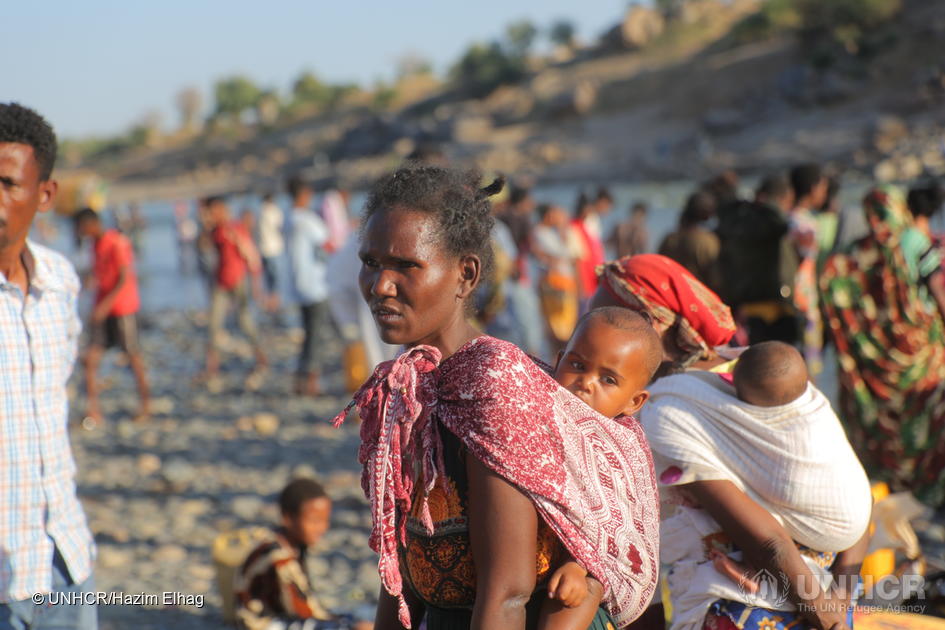 Thousands flee fighting in Ethiopia © UNCHR/Hazim Elhag, 2020.
Thousands flee fighting in Ethiopia © UNCHR/Hazim Elhag, 2020.
5 Things to Know About Ethiopia’s Tigray Conflict
Ethiopia is a key ally to the US in the Horn of Africa, yet internal conflict between the federal government and Tigray poses a risk to regional security and undermines counterinsurgency efforts.
Fighting began in November when the Tigray People’s Liberation Front (TPLF) launched an attack on several nearby military bases. Although the international community urged Prime Minister Abiy Ahmed to restrain further violence he ordered a retaliatory military offensive against the Tigray region. The federal government has officially claimed victory, yet Ethiopia continues to face an atrocious guerilla war.
Here are five things to know about Ethiopia’s Tigray Conflict:
1. Tigray’s Conflict Stems from Enduring Ethnic Divisions
Tigray’s conflict is driven by deep-rooted ethnic divisions. In 1991 the TPLF ousted a military dictatorship that ruled Ethiopia throughout the 1970s and 80s. Although Tigrayans make up less that 6% of Ethiopia’s total population they enjoyed an overwhelming amount of political and military influence for nearly 30 years.
Opposition to the TPLF’s autocratic rule sparked years of anti-government protests and the party was eventually stripped of power when Abiy Ahmed, an ethnic Oromo, was elected Prime Minister in 2018. Soon after Mr. Abiy came to power, Tigrayans were removed from government positions and arrested on security and corruption charges, sparking massive divisions between the federal government and the TPLF. Prime Minister Abiy pledged to unite Ethiopia, strengthen the federal government’s power, and improve democracy. However, Mr. Abiy’s reforms fed grievances among Tigrayans seeking autonomy from the federal government.
2. Prime Minister Abiy Ahmed is Losing Credibility
When Prime Minister Abiy came to power he was praised for his symbolic gestures of peace and democratic reform; his party freed political prisoners, welcomed back exiled opposition groups, and mediated regional conflicts. However, in 2020 Mr. Abiy was ridiculed for his anti-democratic practices as he arrested journalists and opposition leaders and threatened freedom of speech.
The Ethiopian government issued a six-month state of emergency and imposed a five-week communications blackout when fighting broke out in Tigray. The media, human rights groups, and UN agencies were restricted from gaining access to Tigray and Mr. Abiy has repeatedly denied claims of civilian casualties as well as an Eritrean military presence in the region.
3. The Humanitarian Situation is Getting Worse
Tigray’s humanitarian crisis is intensifying. 2.3 million people need lifesaving assistance and Ethiopian authorities have reportedly blocked humanitarian aid for civilians and refugees fleeing violence. Malnutrition and water-borne illnesses are on the rise as access to food, clean water, and health services deplete. large scale food distribution has proved challenging as sporadic fighting, resistance from officials, and the destruction of travel routes continues. Experts fear that displacement has fueled a massive transmission of COVID-19 infections, putting further strain on an already weakened health system.
In addition, over two million people have been displaced because of the Tigray conflict and have fled to neighboring Sudan, a country already burdened with food insecurity, the coronavirus pandemic, and devastating floods.
4. Eritrea is Heavily Involved
Tigray is bordered by Eritrea in the north, and the two governments have a history of violent territorial disputes. Eritrea has sided with Ethiopia’s federal government to weaken the TPLF and gain power in a long-standing rivalry. In November, the TPLF fired rockets into Eritrea accusing the country of sending troops into Tigray to support Mr. Abiy’s forces. Although the Eritrean government denies claims of military involvement, on-the-ground sources have verified the presence of Eritrean troops in the region.
96,000 citizens have fled Eritrea’s autocratic government seeking refuge in neighboring Tigray. UN officials have expressed concern as Eritrea uses Tigray’s instability as an opportunity to kill, abduct, and forcibly return Eritrean refugees living in Tigrayan refugee camps.
5. Ethiopia’s Instability Threatens the Horn of Africa
Over the past decade Ethiopia has played a key role in maintaining security in the Horn of Africa. However, the country’s internal strife has undermined regional security efforts, leaving room for non-state actors to expand. Ethiopia has been a main supplier of forces acting under AMISOM, an AU peacekeeping mission focused on countering al-Shabab. Prime Minister Abiy’s withdrawal of approximately 3,000 Ethiopian troops from Somalia to fight against the TPLF has significantly weakened the containment of al-Shabab, increasing instability in the country and undermining AMISOM’s counterinsurgency efforts.
Wider Consequences
Ethiopia has been an essential ally to US security efforts in the Horn of Africa. As sporadic fighting continues and the humanitarian situation worsens, Ethiopia moves farther away from democratic ideals and impairs regional security efforts to counter violent extremism.





